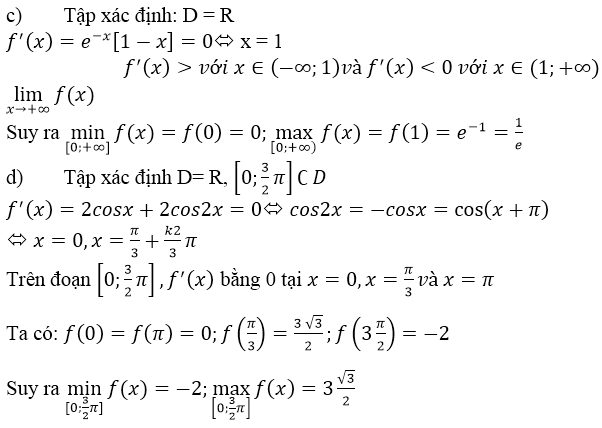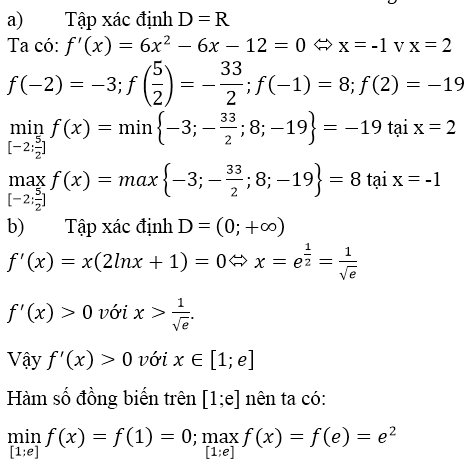Hãy nhập câu hỏi của bạn vào đây, nếu là tài khoản VIP, bạn sẽ được ưu tiên trả lời.

1/ \(f'\left(x\right)=\frac{3\sqrt{x^2+1}-\frac{x\left(3x+1\right)}{\sqrt{x^2+1}}}{x^2+1}=\frac{3\left(x^2+1\right)-3x^2-x}{\left(x^2+1\right)\sqrt{x^2+1}}=\frac{3-x}{\left(x^2+1\right)\sqrt{x^2+1}}\)
Hàm số đồng biến trên \(\left(-\infty;3\right)\) nghịch biến trên \(\left(3;+\infty\right)\)
\(\Rightarrow f\left(x\right)\) đạt GTLN tại \(x=3\)
\(f\left(x\right)_{max}=f\left(3\right)=\frac{10}{\sqrt{10}}=\sqrt{10}\)
2/ \(y'=\frac{\sqrt{x^2+2}-\frac{\left(x-1\right)x}{\sqrt{x^2+2}}}{x^2+2}=\frac{x^2+2-x^2+x}{\left(x^2+2\right)\sqrt{x^2+2}}=\frac{x+2}{\left(x^2+2\right)\sqrt{x^2+2}}\)
\(f'\left(x\right)=0\Rightarrow x=-2\in\left[-3;0\right]\)
\(y\left(-3\right)=-\frac{4\sqrt{11}}{11}\) ; \(y\left(-2\right)=-\frac{\sqrt{6}}{2}\) ; \(y\left(0\right)=-\frac{\sqrt{2}}{2}\)
\(\Rightarrow\left\{{}\begin{matrix}M=-\frac{\sqrt{2}}{2}\\N=-\frac{\sqrt{6}}{2}\end{matrix}\right.\) \(\Rightarrow MN=\frac{\sqrt{12}}{4}=\frac{\sqrt{3}}{2}\)
Tất cả các đáp án đều sai
3/ \(\left\{{}\begin{matrix}\left|x-3\right|\ge0\\\sqrt{x+1}>0\end{matrix}\right.\) \(\Rightarrow f\left(x\right)\ge0\) \(\forall x\Rightarrow N=0\) khi \(x=3\)
- Với \(0\le x< 3\Rightarrow f\left(x\right)=\left(3-x\right)\sqrt{x+1}\)
\(\Rightarrow f'\left(x\right)=-\sqrt{x+1}+\frac{\left(3-x\right)}{2\sqrt{x+1}}=\frac{-2\left(x+1\right)+3-x}{2\sqrt{x+1}}=\frac{-3x+1}{2\sqrt{x+1}}\)
\(f'\left(x\right)=0\Rightarrow x=\frac{1}{3}\)
- Với \(3< x\le4\Rightarrow f\left(x\right)=\left(x-3\right)\sqrt{x+1}\)
\(\Rightarrow f'\left(x\right)=\sqrt{x+1}+\frac{x-3}{2\sqrt{x+1}}=\frac{2\left(x+1\right)+x-3}{2\sqrt{x+1}}=\frac{3x-1}{2\sqrt{x+1}}>0\) \(\forall x>3\)
Ta có: \(f\left(0\right)=3\) ; \(f\left(\frac{1}{3}\right)=\frac{16\sqrt{3}}{9}\) ; \(f\left(4\right)=\sqrt{5}\)
\(\Rightarrow M=\frac{16\sqrt{3}}{9}\Rightarrow M+2N=\frac{16\sqrt{3}}{9}\)
Câu 2 hình như câu B mà người ta nói đạt GTLN . GTNN tại M , N nên là 0 x -2 =0

a) y = f(x) = x3 – 3mx2 + 3(2m-1)x + 1
Tập xác định: D = R
y’= 3x2 -6mx + 3(2m-1) = 3(x2 – 2mx + 2m – 1)
Hàm số đồng biến trên D = R ⇔ y’ ≥ 0, ∀x ∈ R
⇔ x2 – 2mx + 2m - 1≥0, ∀x ∈ R
⇔ Δ’ = m2 – 2m + 1 = (m-1)2 ≤ 0 ⇔ m =1
b) Hàm số có một cực đại và một cực tiểu
⇔ phương trình y’= 0 có hai nghiệm phân biệt
⇔ (m-1)2 > 0 ⇔ m≠1
c) f’’(x) = 6x – 6m > 6x
⇔ -6m > 0 ⇔ m < 0

bn ơi câu a t chưa làm chưa biết nhưng câu b chắc chắn có Max tại x=-3 nhé ! Nếu bn chỉ tìm ra Min là chưa đủ

3.
\(y'=-3x^2-6x=0\Rightarrow\left[{}\begin{matrix}x=-2\\x=0\end{matrix}\right.\)
\(y\left(-1\right)=m-2\) ; \(y\left(1\right)=m-4\)
\(\Rightarrow y_{min}=y\left(1\right)=m-4\)
\(\Rightarrow m-4=0\Rightarrow m=4\)
4.
Hàm đã cho bậc nhất trên bậc nhất nên đơn điệu trên mọi khoảng xác định
\(\Rightarrow y_{min}+y_{max}=y\left(1\right)+y\left(2\right)=\frac{m+1}{2}+\frac{m+2}{3}=8\)
\(\Rightarrow m=\frac{41}{5}\)
Đáp án B
1.
\(y'=\frac{1}{\left(sinx+1\right)^2}.cosx>0\Rightarrow y\) đồng biến
\(m=y_{min}=y\left(0\right)=2\)
\(M=y_{max}=y\left(1\right)=\frac{5}{2}\)
\(\Rightarrow M^2+m^2=\frac{41}{4}\)
2.
Hàm xác định trên \(\left[-2;2\right]\)
\(y'=1-\frac{x}{\sqrt{4-x^2}}=0\Leftrightarrow x=\sqrt{2}\)
\(y\left(-2\right)=-2\) ; \(y\left(\sqrt{2}\right)=2\sqrt{2}\) ; \(y\left(2\right)=2\)
\(\Rightarrow N=-2;M=2\sqrt{2}\)
\(\Rightarrow M+2N=2\sqrt{2}-4\)

Xét hàm \(g\left(x\right)=3x^4-4x^3-12x^2+m\)
\(g'\left(x\right)=12x^3-12x^2-24x=0\) \(\Rightarrow\left[{}\begin{matrix}x=0\\x=-1\\x=2\end{matrix}\right.\)
\(g\left(-3\right)=m+243\) ; \(g\left(-1\right)=m-5\) ; \(g\left(0\right)=m\) ; \(g\left(2\right)=m-32\)
Xét phương trình: \(g\left(x\right)=0\Leftrightarrow3x^4-4x^3-12x^2=-m\)
Từ BBT ta thấy để pt đã cho có nghiệm trên \(\left[-3;2\right]\)
\(\Leftrightarrow-32\le-m\le243\Rightarrow-243\le m\le32\)
- Vậy với \(-243\le m\le32\Rightarrow b=0\)
Khi đó \(2b\ge a\) luôn luôn không thỏa mãn
- Với \(32< m< 2019\) \(\Rightarrow\left\{{}\begin{matrix}a=m+243\\b=m-32\end{matrix}\right.\)
\(2b\ge a\Leftrightarrow2m-64\ge m+243\Rightarrow m\ge307\)
\(\Rightarrow\) Trên khoảng này có \(2018-307+1=1712\) giá trị nguyên
- Với \(-2019< m< -243\) \(\Rightarrow\left\{{}\begin{matrix}a=-m+32\\b=-m-243\end{matrix}\right.\)
\(2b\ge a\Leftrightarrow-2m-486\ge-m+32\Leftrightarrow m\le-518\)
Trên đoạn này có \(2018-518+1=1501\) giá trị nguyên
Tổng cộng có \(1712+1501=3213\) giá trị nguyên
(Nếu như tất cả các từ khoảng - đoạn bạn sử dụng đều chính xác). Vì câu đầu tiên bạn dùng chữ "đoạn" nhưng lại sử dụng kí hiệu "khoảng" nên mình đành đoán nó là đoạn \(\left[-3;2\right]\) , đoạn cuối sử dụng kí hiệu khoảng nên đoán nó ko lấy 2 đầu mút

1. \(f\left(x\right)=e^{2-3x}\) trên đoạn \(\left[0;2\right]\)
Ta có :
\(f'\left(x\right)=-3e^{2-3x}< 0\) với \(x\in R\Rightarrow\) hàm số nghịch biến trên đoạn \(\left[0;2\right]\)
Với \(0\le x\le2\Leftrightarrow f\left(0\right)\ge f\left(x\right)\ge f\left(2\right)\Leftrightarrow e^2\ge f\left(x\right)\ge\frac{1}{e^4}\)
\(\Leftrightarrow\begin{cases}Max_{x\in\left[0;2\right]}f\left(x\right)=e^2;x=0\\Min_{x\in\left[0;2\right]}f\left(x\right)=\frac{1}{e^4};x=2\end{cases}\)
2. \(f\left(x\right)=e^{\sqrt{1-x^2}}\) trên đoạn \(\left[-1;1\right]\)
Ta có :
\(f'\left(x\right)=\frac{-x}{\sqrt{1-x^2}}e^{\sqrt{1-x^2}}=0\Leftrightarrow x=0\in\left[-1;1\right]\)
Mà : \(\begin{cases}f\left(-1\right)=1\\f\left(0\right)=e\\f\left(1\right)=1\end{cases}\) \(\Leftrightarrow\begin{cases}Max_{x\in\left[-1;1\right]}f\left(x\right)=e;x=0\\Min_{x\in\left[-1;1\right]}f\left(x\right)=1;x=\pm1\end{cases}\)

a) f(x) = 2x3 – 3x2 – 12x + 1 ⇒ f’(x) = 6x2 – 6x – 12
f’(x) = 0 ⇔ x ∈ {-1, 2}
So sánh các giá trị:
f(x) = -3; f(-1) = 8;
f(2) = -19, f(52)=−332f(52)=−332
Suy ra:
maxx∈[−2,52]f(x)=f(−1)=8minx∈[−2,52]f(x)=f(2)=−19maxx∈[−2,52]f(x)=f(−1)=8minx∈[−2,52]f(x)=f(2)=−19
b) f(x) = x2 lnx ⇒ f’(x)= 2xlnx + x > 0, ∀ x ∈ [1, e] nên f(x) đồng biến.
Do đó:
maxx∈[1,e]f(x)=f(e)=e2minx∈[1,e]f(x)=f(1)=0maxx∈[1,e]f(x)=f(e)=e2minx∈[1,e]f(x)=f(1)=0
c) f(x) = f(x) = xe-x ⇒ f’(x)= e-x – xe-x = (1 – x)e-x nên:
f’(x) = 0 ⇔ x = 1, f’(x) > 0, ∀x ∈ (0, 1) và f’(x) < 0, ∀x ∈ (1, +∞)
nên:
maxx∈[0,+∞)f(x)=f(1)=1emaxx∈[0,+∞)f(x)=f(1)=1e
Ngoài ra f(x) = xe-x > 0, ∀ x ∈ (0, +∞) và f(0) = 0 suy ra
maxx∈[0,+∞)f(x)=f(0)=0maxx∈[0,+∞)f(x)=f(0)=0
d) f(x) = 2sinx + sin2x ⇒ f’(x)= 2cosx + 2cos2x
f’(x) = 0 ⇔ cos 2x = -cosx ⇔ 2x = ± (π – x) + k2π
⇔ x∈{−π+k2π;π3+k2π3}x∈{−π+k2π;π3+k2π3}
Trong khoảng [0,3π2][0,3π2] , phương trình f’(x) = 0 chỉ có hai nghiệm là x1=π3;x2=πx1=π3;x2=π
So sánh bốn giá trị : f(0) = 0; f(π3)=3√32;f(π)=0;f(3π2)=−2f(π3)=332;f(π)=0;f(3π2)=−2
Suy ra:
maxx∈[0,3π2]f(x)=f(π3)=3√32minx∈[0,3π2]f(x)=f(3π2)=−2




Chọn C
Giá trị lớn nhất của hàm số f(x) trên [-3;2], ta có:
M = 2, m = -4 suy ra M - m = 6